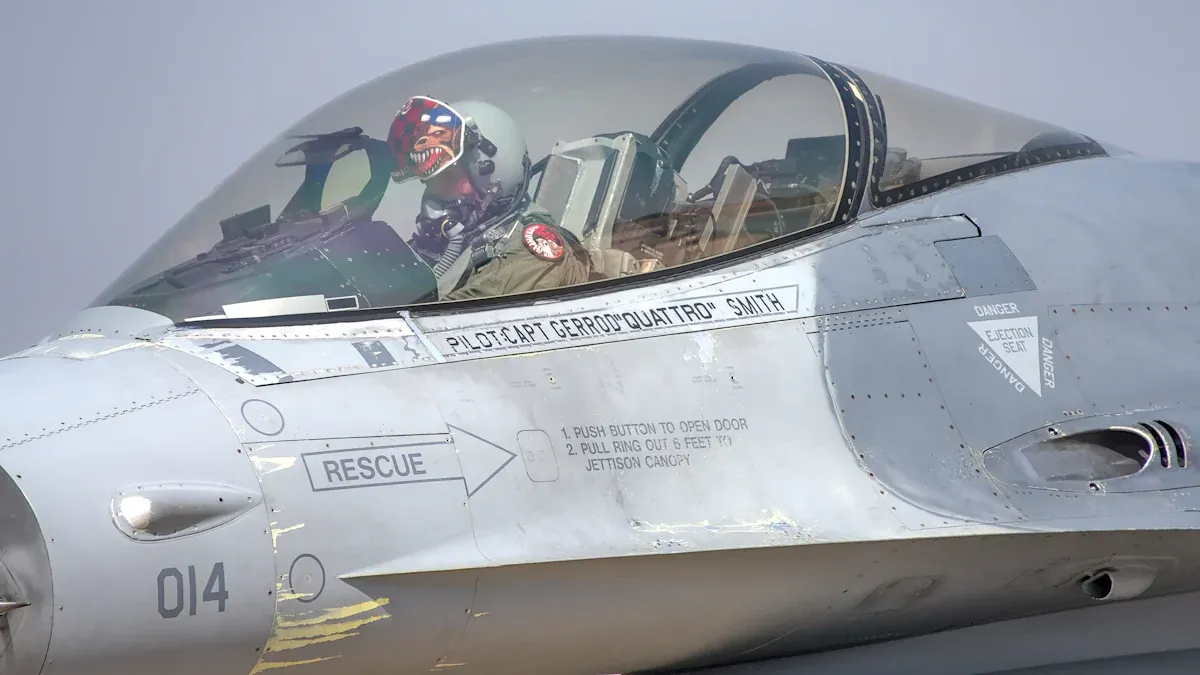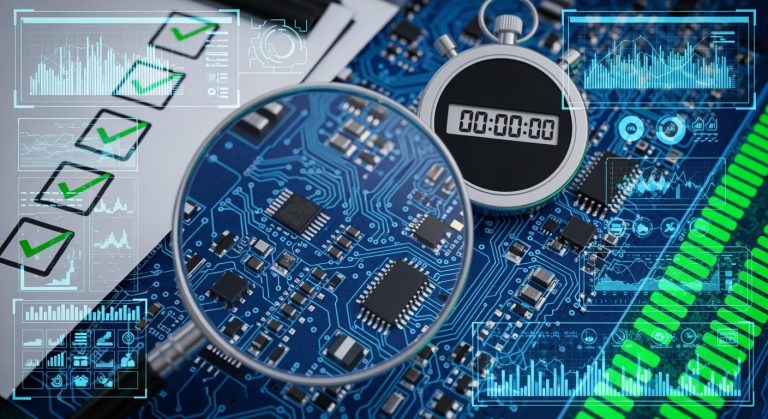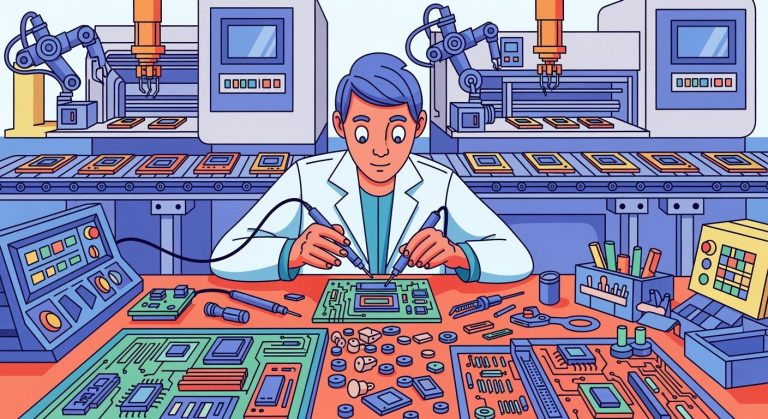Understanding the Role of PCBs in the J-10 Aircraft Design
Printed Circuit Boards (PCBs), specifically the J-10 Aircraft PCB, are very important in the J-10 jet. They are the main part of its advanced systems. The J-10 Aircraft PCB helps different parts of the jet communicate with each other. This ensures that data is processed correctly and decisions are accurate. They also help manage power efficiently, making the jet lighter and improving its performance. Their robust design can withstand tough flying conditions, keeping the jet safe and reliable. Utilizing advanced PCBs like the J-10 Aircraft PCB helps the J-10 perform at a high level.
Key Takeaways
- PCBs are important for the J-10 jet. They link sensors and systems to work together smoothly.
- They help with flying, saving data, and handling power. This keeps the jet safe and working well.
- Better PCBs make the J-10 lighter. This lets it carry more tools and fly farther.
- Engineers test PCBs carefully to handle tough conditions. This makes the jet dependable.
- New PCB technology, like using AI, will improve how the J-10 works and what it can do.
Overview of the Role of PCBs in Aviation
What Are PCBs and Their Key Functions
Printed Circuit Boards (PCBs) are very important in airplanes today. They act as the main connection for electronic parts like sensors and processors. PCBs have many jobs that help planes work smoothly. These include controlling flights, recording data, sharing power, and helping communication.
The table below shows what PCBs do in airplanes:
| Function | Description |
|---|---|
| Flight Control | PCBs turn pilot commands into actions to move the plane safely. |
| Data Recording | They help save important flight data for safety checks. |
| Power Distribution | PCBs send energy to parts efficiently, making systems reliable. |
| Communication Systems | They allow pilots to stay in touch with ground teams easily. |
These tasks show how PCBs keep planes stable, safe, and working well.
Importance of PCBs in Modern Aircraft
Modern planes depend on PCBs to handle complex systems. PCBs process flight data and give pilots real-time updates. Sensors on PCBs check height, speed, and temperature for accurate flying. Communication tools on PCBs help pilots talk to ground teams clearly.
PCBs also control flight systems and guide the plane. They manage energy flow to keep all parts powered evenly. Their strong build helps them survive tough flying conditions, making them key for safety.
If PCBs fail, it can cause big problems. This is why airplane makers focus on making high-quality PCBs. Good PCBs ensure planes stay safe, steady, and easy to control during flights.
How PCBs Enhance Aviation Technology
PCBs help improve airplane technology by connecting advanced systems. They process signals from sensors and guide pilots with useful information. Strong PCBs made of copper or aluminum are used in flight controls for accuracy.
These boards also support quick communication, helping pilots react fast to changes. Their design saves energy and boosts efficiency. New materials and methods make PCBs better, stronger, and longer-lasting.
Future PCBs will be smaller and smarter, making planes even better. By improving speed, safety, and reliability, PCBs lead the way in aviation progress.
Applications of PCBs in the J-10 Aircraft
J-10 Aircraft PCB in Avionics Systems
The J-10 jet uses advanced systems to handle tough tasks. PCBs connect sensors, processors, and communication tools in these systems. They help share data smoothly so the jet can process information quickly.
Strong PCBs improve navigation and radar systems for the J-10. They make targeting and tracking more accurate, which is vital for missions. These PCBs are built to survive fast flights and extreme heat. With these advanced boards, the J-10 performs well and stays dependable during defense operations.
Contribution to Flight Control and Stability
Flight control in the J-10 depends on PCBs for smooth flying. The PCB design fits into the jet’s structure, making it lighter and easier to build. It measures pressure differences using fewer sensors, which boosts efficiency.
The J-10 PCB has five sensors that measure pressure changes up to ±500 Pa. These sensors give precise data, helping the jet adjust to its surroundings quickly. This accuracy keeps the J-10 steady during fast moves and ensures safe flying in tough conditions.
- Benefits of PCBs in flight control:
- Easier assembly and lighter weight.
- Fewer sensors for better efficiency.
- Accurate pressure readings for stable flying.
Power Distribution and Weight Optimization
Managing power is key for the J-10’s systems to work well. The PCB spreads energy evenly, preventing overloads and keeping parts running longer. This smart energy use lowers the chance of system problems.
Lightweight PCBs help reduce the jet’s overall weight. This lets the J-10 carry more equipment and fly farther. The table below shows how PCB design improves the jet’s abilities:
| Performance Statistic | Impact on J-10 Aircraft |
|---|---|
| Reduced Weight | Carries more equipment and flies longer |
| Extended Battery Life | Uses energy better for longer missions |
Efficient power use and lighter PCBs make the J-10 a strong and flexible jet for military tasks.
Challenges and Innovations in J-10 Aircraft PCB Design
Reliability in Harsh Operational Conditions
The J-10 jet flies in tough environments, so its PCBs must handle stress. Engineers design PCBs to stay strong in extreme conditions like fast temperature changes, high moisture, and corrosive air. To ensure they work well, engineers run many tests.
Key tests for PCB reliability include:
- High Accelerated Temperature and Humidity Stress Testing (HAST): Checks if PCBs can handle heat and moisture without damage like peeling or rust.
- Temperature Cycling Testing: Tests if PCBs survive big temperature swings. It finds weak spots in solder and connections.
- Salt Spray Testing: Measures how well PCBs resist salty air, which is important for jets near oceans or factories.
These tests make sure the J-10’s PCBs work in hard conditions. By solving these problems, engineers make the jet safer and more reliable.
Signal Integrity and Electromagnetic Compatibility
Good signals are key for the J-10’s systems to work right. PCBs must send signals clearly between parts for smooth communication and accurate data. Electromagnetic compatibility (EMC) stops systems from interfering with each other.
New PCB designs improve signal clarity. The table below shows how different PCB models perform in high-frequency tasks:
| Model | Frequency Range | Insertion Loss Accuracy | Effective Dielectric Constant |
|---|---|---|---|
| H&J Model | Up to 15 GHz | Less accurate | N/A |
| Cannonball Model | Up to 50 GHz | More accurate | 3.76 @ 10GHz |
| CMP-28 Model | Up to 50 GHz | Excellent correlation | N/A |
The CMP-28 model works best for the J-10’s advanced systems. Better signals mean flight controls work faster and without mistakes, improving the jet’s performance.
Advances in Materials and Manufacturing
New materials and methods have changed PCB design for military jets. Engineers now use strong materials like heat-resistant laminates and copper layers. These materials help PCBs handle the heat from fast flying.
Modern tools like laser drills and precise cutting make smaller, lighter PCBs. These PCBs save weight, helping the J-10 use less fuel and carry more gear.
Automated assembly also improves quality and reduces mistakes. These updates make PCBs stronger and cheaper, helping the J-10 succeed in defense missions.
Future Trends in PCB Technology for the J-10
Smaller PCBs and High-Density Connections
The J-10 jet needs smaller and better PCBs. High-density interconnect (HDI) technology helps make this possible. Engineers use new methods like mSAP and aSAP to create tiny lines and spaces. These techniques allow more circuits in less space and improve speed.
Main HDI PCB improvements include:
- Thinner lines and spaces for better designs.
- Smaller holes and narrower paths for complex systems.
- Better heat control for tightly packed circuits.
These changes make avionics and flight systems work better. They help the J-10 stay dependable for defense missions.
Smart PCBs with AI Features
Smart PCBs are changing how military jets like the J-10 work. Adding artificial intelligence (AI) helps these boards handle tough tasks. AI-powered PCBs can predict problems and improve performance instantly.
For example, smart PCBs let avionics check data from many sensors at once. This helps pilots make better choices during missions. AI also helps with maintenance by spotting issues early, reducing repair time.
New Technologies for Military Jets
New PCB technologies are shaping the future of military planes. Stronger materials like flexible layers and high-frequency laminates make PCBs last longer. IoT and 5G improve communication and awareness in the J-10.
The table below shows key trends and their effects:
| Aspect | Insights |
|---|---|
| Demand for PCBs | Growing due to advanced systems and lighter designs. |
| Cybersecurity Needs | Better encryption keeps important data safe. |
| Eco-Friendly Trends | Recyclable materials lower harm to the environment. |
| Future Goals | AI-designed PCBs improve performance and find problems early. |
These updates keep the J-10 ready for future challenges and missions.
PCBs are crucial for the J-10 jet’s systems. They support avionics, flight control, and power management. Their strong design helps them work in tough conditions. This makes them essential for defense missions. Engineers keep improving PCBs to make them stronger and better. These upgrades help the jet perform well in hard situations. Future PCB trends, like using AI and making them smaller, will improve the J-10 even more. With constant research, the J-10 shows how aviation technology keeps advancing.
FAQ
Why are PCBs important for the J-10 jet?
PCBs are key to the J-10’s electronic systems. They link sensors, processors, and communication tools for smooth data sharing. Their strong design helps with avionics, flight control, and power use. This makes the jet work well in tough conditions.
How do PCBs help with the J-10’s flight control?
PCBs use sensor data to improve flight control. They help the jet react quickly to changes in the environment. Their lightweight design lowers the jet’s weight, making it easier to move and more efficient.
What problems do PCBs face in military jets like the J-10?
PCBs in military jets deal with harsh conditions like fast temperature shifts, high moisture, and signal interference. Engineers solve these problems with strong materials, better building methods, and careful testing to keep them reliable.
How does AI make PCBs better in the J-10?
AI helps PCBs check sensor data instantly. This improves choices during missions and boosts system performance. AI also predicts problems early, helping fix issues before they cause trouble.
What new PCB features will improve the J-10?
Future PCBs will be smaller, smarter, and more connected. These upgrades will make the jet lighter, faster, and more efficient. New materials and ideas will make PCBs tougher and better for missions.




















